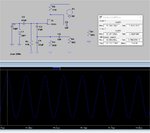Imalu3055
Member level 1
Hello.
It looks mounted backwards because that is a J310 and there was another one before. What I will do is remove the plate from the chassis and analyze it thoroughly.
I clarify my disappointment: I have mounted Colpitts variable frequency oscillators with 6L6 valve and they worked instantly!
Thanks
It looks mounted backwards because that is a J310 and there was another one before. What I will do is remove the plate from the chassis and analyze it thoroughly.
I clarify my disappointment: I have mounted Colpitts variable frequency oscillators with 6L6 valve and they worked instantly!
Thanks






